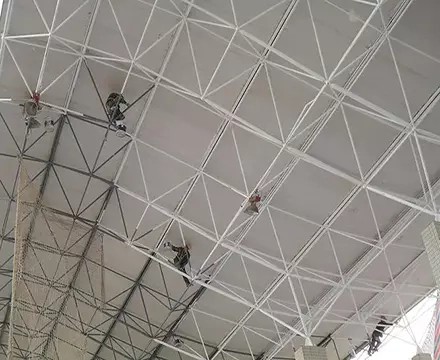Dapeng Town Industrial Park, Tongshan District, Xuzhou City, Jiangsu Province, China
Compared to traditional concrete structures, space frame steel structures offer many advantages, but their fire resistance is undoubtedly a significant weakness, especially when exposed to high temperatures. Under these conditions, the strength and elasticity of the steel materials used in space frame steel structures are significantly affected, and the risk of severe damage or even building collapse in case of a fire is high. To prevent such situations, it is essential to focus on the selection of fire-resistant coatings. This article discusses the key components of suitable fire-resistant coatings for space frame steel structures.

1. Carbonizing Agent:
The carbonizing agent is a material that forms a non-combustible foam carbonization layer under high-temperature conditions, which contributes to the structural integrity of space frame steel structures.
2. Conventional Epoxy Resin:
Conventional epoxy resin, when combined with other components, ensures that the coating has various applications under normal conditions while providing flame resistance and excellent polyurethane foam expansion properties in case of exposure to flames or high temperatures.
3. Metal Catalyst:
A metal catalyst is a substance that dissolves phosphoric acid under specific conditions, which, in turn, allows polyether polyol to dehydrate, forming a non-combustible foam carbonization layer in space frame steel structures. Phosphoric acid tricyanuramide has low water solubility, balancing catalytic reactions and polyurethane foam expansion.
4. Foaming Agent:
A foaming agent is a substance that induces the desired chemical reaction. It can be classified into organic chemical foaming agents, physical foaming agents, and surfactants. These agents create tiny pores in high polymers when they release gases like carbon dioxide and nitrogen upon heating, producing a cellular structure. Expanding fire-resistant coatings for space frame steel structures work by forming an expanding layer when the foaming agent functions. The foaming agent dissolves upon exposure to fire and releases gases such as ammonia, carbon dioxide, or hydrogen halide. This process creates a cellular structure as the coating reaches its softening point.
In summary, space frame steel structure fire-resistant coatings typically consist of several key components, including carbonizing agents, conventional epoxy resins, metal catalysts, and foaming agents. To ensure the safety and extended lifespan of steel structure buildings, it is crucial for relevant professionals to rigorously assess coating performance and quality during the design of space frame structures.